The perfect frozen yoghurt. Photograph: Felicity Cloake for the GuardianFroyo is having another moment, 30 years after it emerged as a low-fat alternative to ice cream. Make your own to avoid the extra sugar and additives found in some shop-bought varieties – as well as the hefty price tag.Frozen yoghurt, that darling of 1980s Lycra-clad America, is back with a vengeance and this time its got Europe in its sights. We never really warmed to the idea of a low-fat ice-cream alternative during the first frogurt boom years, but with UK sales up by 500% last summer, it looks as if were finally getting sucked into what the New York Observer has scornfully described as the gleeful fantasy of being able to eat whatever you want with no consequences.
To no one's great surprise, it turns out frozen yoghurt isn't exactly what it says on the tub, just as there's a bit more to ice-cream than just iced cream sugar and stabilisers come as standard, to say nothing of the various thickeners and powders added to some brands. It is, however, pretty expensive according to one calculation, American frozen yoghurt shops slap a 500% mark-up on their regular serving size. Both excellent reasons to have a go at making your own.
The dairy
Frozen yoghurt is generally sold on its low-fat credentials, rather than its distinctive, sour flavour, but little is made of the fresher, lighter texture that comes from this lower fat content. Even the highest-fat Greek yoghurts, which have had much of their liquid strained off, will only be about 10%, as opposed to the 48% in the double cream used in many traditional ice-creams, rendering the use of low-fat varieties slightly pointless here.
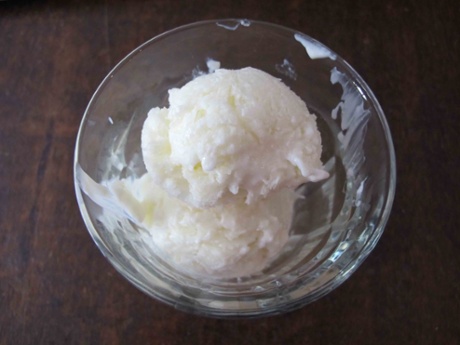
However, in their rush to emphasise this healthy aspect of things, many recipes call for low, or fat-free yoghurts. Erica of the Coffee and Quinoa blog, seeking to recreate the tartness of her favourite frozen yoghurt chain, goes for low-fat yoghurt and skimmed milk. I started out by making a full-fat version with whole-milk yogurt and cream, she says. While it was delicious, it tasted nothing like the Pinkberry in my memory. Using reduced-fat or non-fat Greek yogurt and milk, on the other hand, came very close to that perfect Pinkberry flavor and texture I was going for. Never having sampled Pinkberry, I am unable to verify the authenticity of her recipe, but I won't be rushing there on this evidence; this version tastes thin and bland, like a Mini Milk where they forgot to add the sugar. And it takes its sweet time to soften to a scoopable consistency (one of my panel claims she had to microwave it for a minute to be able to hew a bit off to taste). Obviously Erica has healthier tastes than me.
BBC Good Food uses a mixture of fat-free yoghurt and light condensed milk, which gives an even icier finish, and a weird, slightly powdery texture that I am not keen on. Not at all yoghurty, but somehow both gooey and icy, as someone else has it. A few recipes go the other way, and recommend cutting the yoghurt with something fattier. Morfudd Richards, former owner of the Lola on Ice van, and author of Lola's Ice Creams and Sundaes, uses a mixture of whole-milk Greek yoghurt and double cream. This seems a bit like cheating for the purposes of this column, so I take her up on her suggestion of replacing the cream with extra yoghurt. Even without the hard stuff, her recipe is deliciously rich and creamy, with a lovely smooth texture.
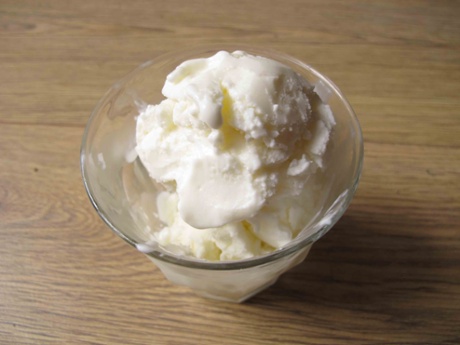
Max Falkowitz, of US food website Serious Eats, isn't a fan of frozen Greek yoghurt at all, preferring the ordinary, unstrained version (which tends to have almost half the fat) on the basis that "the Greek stuff does too good a job - it's too creamy, so much so that when frozen it feels like you're chewing on sour cream." I agree, but for a different reason - the Greek yoghurt I try is noticeably less tangy than the decent standard variety I favour for everyday use, which has a cleaner, fresher, more distinctively yoghurty flavour - "zingy" as one tester puts it.
Sugar
One of the things early American consumers of frozen yoghurt were clear about was that it shouldn't taste too sour - too much like yoghurt, in other words. Indeed, the names of some of the industry's old-timers, I Can't Believe Its Yogurt! and This Can't be Yogurt, suggest the secret of their success: pumping "the soft goop full of enough sugar and flavourings to disguise its - yogurtness the sour flavor that is a byproduct of its fermentation." This has changed a lot in recent years, but still, many of the versions on the market are suspiciously sweet, or packed with other flavourings, such as vanilla, which although necessary with ice-cream, where the principle taste is one of bland creaminess, seems a shame here.
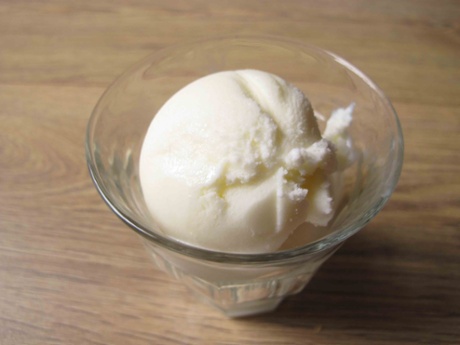
The other reason, of course, is chemical. As Serious Eats explains, "from a physics standpoint, yogurt is a gel: that is, liquid milk suspended in a solid state by a loose matrix of polymers. In Jell-O, those polymers are gelatin molecules; in yogurt, it's coagulated milk proteins. That means despite yogurt's custardy texture, from the ice-cream maker's standpoint, it's just another kind of milk. A lot of yogurt has more fat and less water than an equal volume of milk, and those coagulated proteins do add some creaminess, but the only way to get your frozen yogurt actually creamy is to add a good amount of sugar - more than you might for ice-cream, which has extra fat and egg yolks to help enhance texture." This fact might help dispel any lingering belief that this is something you should eat by the gallon.
The sweetest version I try is that from BBC Good Food, whose light condensed milk makes the whole thing taste a bit like cheap white chocolate. Not necessarily a bad thing, but not exactly what I'm looking for in a frozen yoghurt. Most other people use ordinary white sugar in varying amounts, but the recipe from Sam and Sam Clark of London's Moro restaurant, quoted in Caroline and Robin Weir's definitive work, Ice Creams, Sorbets & Gelati, starts with a kind of Italian meringue of hot, whisked egg whites and sugar. This gives it a beautifully light, clean texture that scoops easily from the dish, but I'm not convinced that it's sufficiently superior to the Serious Eats version to merit the extra half hour of work.
What I do like about the Clarks' recipe is their use of unrefined caster sugar, which makes for a lovely, faintly toffee-ish contrast to the tanginess of the yoghurt. However, my expert testing panel (one of whom is a bona fide American) express reservations about this in a plain frogurt on the basis that the flavour has a tendency to "overpower the yoghurt" - so as a compromise, I'm going to use half brown, half white for the best of both worlds.
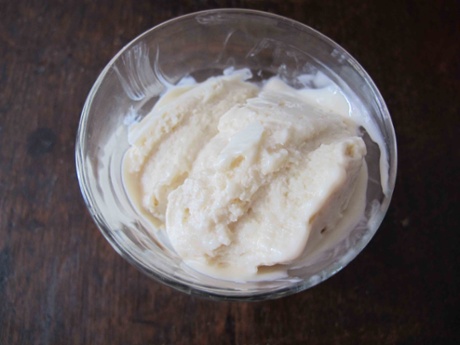
Flavourings
Richards and Erica both add lemon juice to accentuate the natural tartness of the yoghurt, which shouldn't be necessary with the plain whole-milk stuff, though as flavours can vary wildly, it's wise to keep some on hand just in case. Serious Eats sneaks in some salt - just a pinch, but I suspect this plays a part in its superior consistency given that it and the Moro versions are the only ones I'm able to scoop straight from the freezer. Although I prefer my frozen yoghurt plain, you can stir in other flavourings too - BBC Good Food go for strawberries, and Serious Eats has a handy guide here.
Chilling and freezing
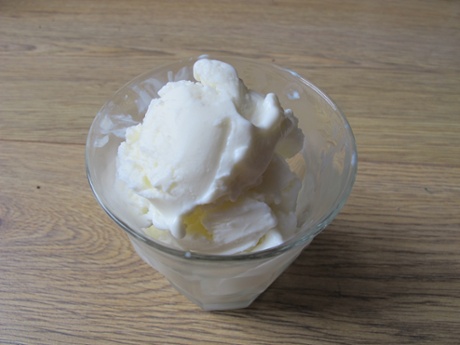
Serious Eats recommends chilling the yoghurt base before churning, which although not strictly necessary does help it freeze more quickly, resulting in a smoother final texture. BBC Good Food just sticks its yoghurt in the freezer without anything in the way of churning, which is, to put it mildly, a very bad idea. As one comment beneath observed, it comes out "super hard as ice!". If you don't have an ice-cream maker, then taking it out and stirring it several times during the freezing procedure will help prevent this. Just make sure you don't eat it all in the process.
The perfect frozen yoghurt
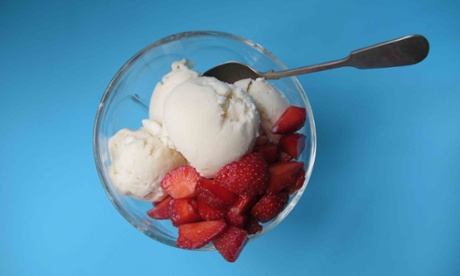
(makes one litre)
1l whole-milk plain yoghurt, chilled
100g unrefined caster sugar
100g white caster sugar
1/4 tsp fine salt
1 lemon (optional)
Whisk together the yoghurt, sugars and salt until the last two have dissolved (when you can't feel any grains on your tongue). Taste and add a little lemon juice if you'd like it tarter, bearing in mind that freezing dulls flavours, so the final version will be less sweet and tart than it is at this point. Put in the fridge for an hour or so if you have time.
Chill your ice-cream maker if using, churn the yoghurt until scoopable, then freeze if you'd prefer a harder texture. (Alternatively, spoon the chilled mix into a shallow box with a lid and freeze for 1-1.5 hours until beginning to solidify. Beat with a fork or whisk to break up the solid pieces, then refreeze and repeat twice more before allowing to freeze undisturbed for an hour before serving.) Remove from the freezer a few minutes before serving to soften.
Frozen yoghurt: ice-cream's skinnier and less interesting cousin, or a fully fledged delight in its own right? Can anyone explain the sudden surge in popularity? And if you are a fan, what do you like to flavour or top yours with? (All ideas welcome, I have a small mountain to get through.)









